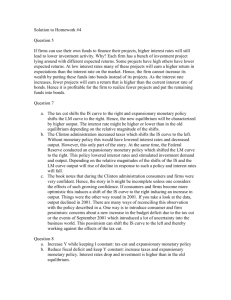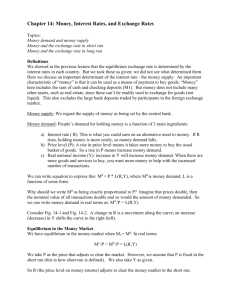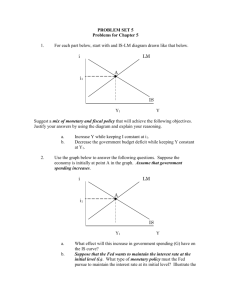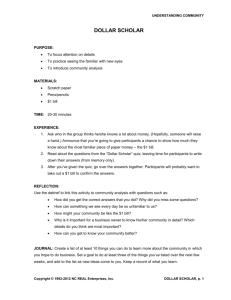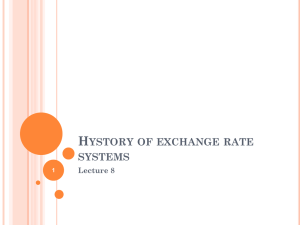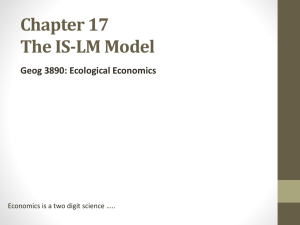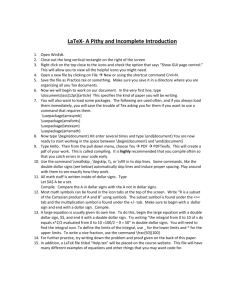Policy Coordination
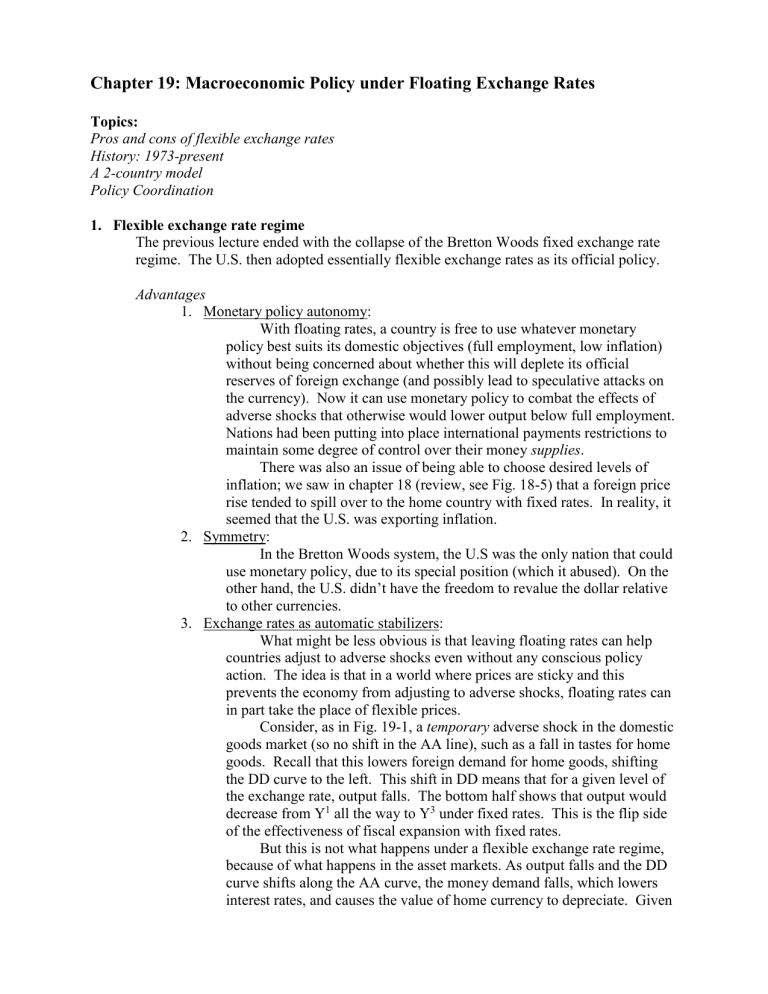
Chapter 19: Macroeconomic Policy under Floating Exchange Rates
Topics:
Pros and cons of flexible exchange rates
History: 1973-present
A 2-country model
Policy Coordination
1.
Flexible exchange rate regime
The previous lecture ended with the collapse of the Bretton Woods fixed exchange rate regime. The U.S. then adopted essentially flexible exchange rates as its official policy.
Advantages
1.
Monetary policy autonomy:
With floating rates, a country is free to use whatever monetary policy best suits its domestic objectives (full employment, low inflation) without being concerned about whether this will deplete its official reserves of foreign exchange (and possibly lead to speculative attacks on the currency). Now it can use monetary policy to combat the effects of adverse shocks that otherwise would lower output below full employment.
Nations had been putting into place international payments restrictions to maintain some degree of control over their money supplies .
There was also an issue of being able to choose desired levels of inflation; we saw in chapter 18 (review, see Fig. 18-5) that a foreign price rise tended to spill over to the home country with fixed rates. In reality, it seemed that the U.S. was exporting inflation.
2.
Symmetry:
In the Bretton Woods system, the U.S was the only nation that could use monetary policy, due to its special position (which it abused). On the other hand, the U.S. didn’t have the freedom to revalue the dollar relative to other currencies.
3.
Exchange rates as automatic stabilizers:
What might be less obvious is that leaving floating rates can help countries adjust to adverse shocks even without any conscious policy action. The idea is that in a world where prices are sticky and this prevents the economy from adjusting to adverse shocks, floating rates can in part take the place of flexible prices.
Consider, as in Fig. 19-1, a temporary adverse shock in the domestic goods market (so no shift in the AA line), such as a fall in tastes for home goods. Recall that this lowers foreign demand for home goods, shifting the DD curve to the left. This shift in DD means that for a given level of the exchange rate, output falls. The bottom half shows that output would decrease from Y 1 all the way to Y 3 under fixed rates. This is the flip side of the effectiveness of fiscal expansion with fixed rates.
But this is not what happens under a flexible exchange rate regime, because of what happens in the asset markets. As output falls and the DD curve shifts along the AA curve, the money demand falls, which lowers interest rates, and causes the value of home currency to depreciate. Given
sticky price levels, this means that home goods are becoming relatively cheaper for the foreign market, so demand picks up a bit. As a result, the final equilibrium is at point 2, where output falls only to Y 2 . The automatic adjustment in exchange rates cushions the effect of a taste shift, by allowing the relative price of home goods to fall, despite the fact that domestic currency prices are sticky in the short run.
Note that the effect is even more pronounced in the case of a permanent drop in demand. Here the expected exchange would also change, shifting the AA line to the right, and leading to greater dollar depreciation with floating rates. The alternative under fixed rates is to either remedy the “fundamental disequilibrium” through currency devaluation or endure domestic unemployment for some time.
Disadvantages
1.
Discipline:
In the real world, there are political considerations. Governments might engage in over-expansionary policies (the ‘inflation bias’ mentioned earlier). Fear of hyperinflation lasted for a long time. But a counterargument is that the Bretton Woods system didn’t end up imposing all that much discipline anyway, given the American policy adventures prior to the collapse of Bretton Woods.
2.
Destabilizing speculation:
If rates float, there can be a lot of speculative investment and large fluctuations. In fact, this seems to have happened. Floating proponents claim that the market fixes all, so that speculators who don’t consider the fundamentals will lose their … True in the long run, but what about the bumpy ride in the meantime? On the other hand, there were plenty of speculative attacks and capital flows under the old system, too.
Another argument is that floating rates cause sensitivity to monetary changes (the flip side of monetary policy being ineffective with fixed rates). Fig. 19-2 shows the effect of a rise in money demand under floating rates. The AA line shifts to the right, since now people will wish to hold the same amount of money (given E) only if they have less income. This adjustment wouldn’t happen under fixed rates (subject to devaluation).
3.
Injury to international trade:
If rates float, there is much greater uncertainty about effective prices, and this can inhibit trade. In principle, one can use the forward rate, but this is (at minimum) a hassle and might be expensive to use.
4.
No real improvement in autonomy:
Critics say that policy-makers won’t just ignore the exchange rate, as this is certainly a politically-sensitive point. There are also spillover effects from devaluation, as workers might demand an increase in wages to cover the higher cost of imports. This is particularly applicable in countries with a relatively high proportion of imported goods.
There are pros and cons with respect to a strong currency. Advantages include lower prices for imports, and lower inflation. Disadvantages include making exports more
difficult and worsening the current account. It can also lead to calls for protectionism - big 3 automobile makers complained about the high dollar hurting their foreign sales.
2.
History under floating exchange rate regimes
Shortly after the Bretton Woods system collapsed in 1973, the first oil shock hit, inducing recession and a fall in output. Countries were free to use expansionary monetary and fiscal policies to raise output, and so they took advantage of the benefits described above. This made the flexible exchange rate regime look very appealing.
Although countries that had recently abandoned the Bretton Woods regime had expected this to be temporary, they now began to view a floating rate regime as a permanent condition.
Recall that the main benefit of fixed exchange rates was that one prevents disruptive swings in the exchange rate, which can hinder international trade and investment. The
1980s, under a regime of flexible exchange rates, was a period of very large exchange rate swings. An important feature of the international macroeconomic experience of
1980s (Fig. 19-3) was a large dollar appreciation in the first half of the decade, and a big dollar depreciation in second half of the decade. A second feature was U.S. developed large current account deficit. Some part of this can be explained by the macroeconomic policies being pursued at the time.
In the late ‘70s, the U.S. was trying to pull out of a recession and had been going it alone with expansionary policies. This led to high U.S. interest rates and a weak dollar.
The new Federal Reserve Chairman Volcker , worried about inflation from the second oil crisis, announce a tight monetary policy in late 1979, including more stringent procedures for controlling monetary growth. The market saw this as credible, and the dollar appreciated rapidly (the contrast with previous expectations). This policy was pursued through the early 1980s, and can be viewed as a leftward shift in the AA curve.
At this same time, the Reagan administration, pursuing supply-side policies cut taxe s. There also was an increase in government defense spending . These two policies can be viewed as shifting the DD curve right. These shifts tended naturally to raise the value of the dollar relative to other currencies (draw). And this also tended to significantly lower the current account balance.
The large fluctuations in the dollar shown above and that in other currencies had destabilizing effects around the world. For example, when the dollar was overvalued and led to a fall in the foreign demand for U.S. goods, this caused many people in the export sector in the U.S. to lose their jobs. This type of disruption generated greater dissatisfaction with flexible exchange rate regimes. During this time, we see attempts by the major developed countries to try to manage the exchange rate to some degree by having central banks intervene in the foreign exchange markets. This was not a move to an actual fixed exchange rate regime, but is often referred to as a “managed float.” They realized that these attempts required that they coordinate their macroeconomic policies.
At periodic summit meetings, they tried to conduct this coordination.
In 1985 the large industrial countries had a meeting in the Plaza hotel in NY , and decided that the value of the dollar was too high, and they would intervene in the foreign exchange market to bring the dollar down. They all worked together to sell dollars and buy other currencies. The dollar did depreciate significantly back to around
1980 level.
In 1987, the G5 countries plus Canada met in Paris . They decided the value of the dollar had fallen enough and tried to stabilize the dollar. They unofficially set
boundaries on dollar – if it moved to the edge of the band, countries would intervene in the foreign exchange market. But wasn’t long before stock market crash hit in fall of
1987. The Federal Reserve increased the money supply, making the dollar depreciate more.
The dollar bottomed out in April 1995. The G7 meeting decided there was a major misalignment, with the dollar undervalued, and stated they would work for the orderly recovery of dollar. The dollar ten began to appreciate, and this has been the trend for the last 6 years.
Some of the reasons for the dollar appreciation over last six years:
1.
Output growth has been much stronger in US over this period. We came out of a recession in 1991, and have had steady growth until recently. Germany and Japan struggled during this time to get out of recession. So the money demand has been rising in US.
2.
But the U.S. has also had a fairly tight monetary policy, with high interest rates; this makes dollar-deposits attractive. Whereas monetary policy has been looser elsewhere (especially in Japan), with low interest rates in the hopes of stimulating output.
3.
Big role of expectations. If people expect looser monetary policy in
Japan than in the U.S. , this shifts out the expected exchange rate, causing a depreciation now. In Europe, people were not sure they could trust the European Central Bank to maintain a tight money supply in Europe.
3.
A Two-country model
To better appreciate this desire to coordinate policies and manage the exchange rate, consider the following analytical model of a two-country world. Recall that the AA-DD model is based on the assumption of a small open economy in the context of a broader world that is too large relative to that country to be affected by that country’s actions.
Now we wish to consider how the actions of one country could affect the economy of a close trading partner of similar size. This model thus will highlight the interdependence that exists between countries that trade a lot with each other.
Consider a world that consists of only two countries, designated as “home” and
“foreign.”
In the home country, we continue to assume that the current account is a positive function of the real exchange rate, and that it is a negative function of domestic disposable income because a rise in income raises consumption, part of which leaks abroad in the form of imports. But now we also assume that the home current account is a positive function of the foreign country’s disposable income, because a rise in foreign income leads to a rise in foreign imports of home goods, which means a rise in home exports:
CA = CA(EP*/P, Y-T, Y*-T*)
Insert this into the goods market equilibrium condition that total demand equal total production of output:
Y = C(Y-T) + I + G + CA(EP*/P, Y-T, Y*-T*)
This is the HH curve , which can be viewed as an equilibrium relationship between home output Y and foreign output Y*, which satisfies home goods market equilibrium.
S ince there are only two countries in this world, the current account in the foreign country must equal the negative of the current account in the home country, converted to foreign units:
CA* = -CA(EP*/P, Y-T, Y*-T*) / (EP*/P)
Insert this into the goods market equilibrium condition in the foreign country:
Y* = C*(Y*-T*) + I* + G* - CA(EP*/P, Y-T, Y*-T*)/ (EP*/P)
This is the FF curve , representing an equilibrium relationship between Y and Y* that satisfies foreign goods market equilibrium.
To draw the HH and FF curves , note that each is upward sloping: a rise in foreign output raises foreign imports from the home country (from either country’s perspective), which raises aggregate demand for the home good, and hence home output. Equilibrium home and foreign output is at the intersection of these two curves. HH is steeper than
FF , because a rise in a country’s output has a greater effect on its own output market than on the foreign one. Along HH (FF), a greater change in Y* (Y) is needed to counteract the excess supply of home (foreign) output caused by a rise in Y (Y*). (Do footnote 4: since s , s*, m , and m* are positive, ss* + s*m + sm* > 0)
What shifts these curves:
HH: anything that changes Y other than an exogenous change in Y*. So a rise in
EP*/P or a rise in G would shift HH to the right (higher Y for any given Y*).
FF: anything that changes Y* other than an exogenous change in Y: So a fall in
EP*/P or a rise in G* would shift FF up (higher Y* for any given Y). a) Consider a fall in home money supply (Fig. 19-5): This pushes up the home interest rate and an appreciation of the dollar, shifting demand toward foreign goods and away from home goods. This shifts the HH curve to the left and shifts the FF curve up. The equilibrium level of home output falls and the equilibrium level of foreign output rises. Note that the opposite of this (monetary expansion) is given the name of a “beggar-thyneighbor” policy, because you make yourself better off at the expense of your foreign neighbors. b) Consider an expansionary fiscal policy at home Fig. 19-6) : This rise in domestic demand shifts the HH curve right, raising Y for any given Y*.
But we know that part of the demand will leak away in the form of a worsening home current account. This leakage represents a rise in the foreign current account, and this rise in demand for foreign goods shifts the FF curve upward. In the new equilibrium, both home and foreign output rise. In fact, Y rises more here than was the case for fiscal policy in the small open economy models we considered previously, where we did not consider the effects on the rest of the world. Recall that the fiscal
policy effect on home demand is moderated by an increase in leaks away in the form of home demand for foreign goods. But since this raises foreign income, this will lead to some leakage of foreign demand back again to the home country. In this case the spillovers are considered a positive thing, unlike the beggar thy neighbor policy above.
4.
Policy coordination
The fact that economic policies in one country can spill over to affect other countries indicates a degree of interdependence between countries. This interdependence helps explain some of the effort among macroeconomic policy makers in the leading industrial countries to achieve policy coordination. Governments, line people, are often self-interested, and don’t care about the negative externalities imposed on their neighbors
(examples include acid rain, global warming, etc.).
The text promotes policy coordination with floating rates as the most promising system, suggesting that fixed exchange rates are not even possible (without strict capital over capital movements) in a financially integrated world. This coordination is needed to avoid bad “equilibrium” outcomes. The appendix to the chapter shows how the alternative choices of home and foreign monetary policy lead to various outcomes. This is put into the form of a Prisoner’s Dilemma game, where one’s best strategy (in terms of maximizing own payoffs) is always to choose the very restrictive monetary policy.
Draw the game in Fig. 19A-1 and show how it translates into the game in Fig. 19A-2 – the payoffs are / U for each country. Note (point out) how each country has a dominant strategy, always doing better with the very restrictive monetary policy, regardless of the other country’s choice.
This interaction may instead resemble a coordination game, such as the one below:
A B
A 5,5 8,0
B 0,8 10,10
While both (A,A) and (B,B) are equilibria, it is obvious that both countries would prefer the (B,B) outcome. It is risky to play B, but the benefits of coordination are clear here.
